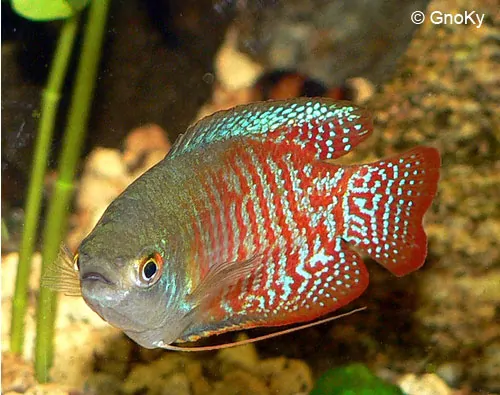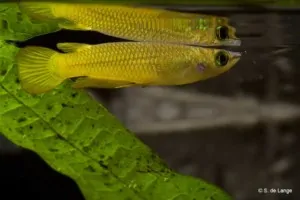Trichogaster lalius – Dwarf Gourami
Trichogaster lalius was first described by Hamilton in 1822. The species name Trichogaster can be broken down into two ancient Greek words: Thrix means ‘hair’ and gaster means ‘stomach’. A reference to the long hair-like threads on the chest of this species.
Synonyms: Trichopodus lalius, Colisa lalius, Polyacanthus lalius, Colisa lalia, Colisha lalius, Colisa unicolor.
.
Description
The name Dwarf Gourami has been given to this species for a reason. They grow to a maximum of six to eight centimeters in length. The females remain much smaller than the males.
The males of the small Trichogaster lalius have a red body with blue reflective stripes. The dorsal, anal and pelvic fins also mainly have this striking shade of blue. The caudal fin has the same striped pattern as the body. Furthermore, both the males and the females have two pelvic-fin rays.
The females are easy to distinguish from the males because they are duller in color. The female is completely silver-grey. In addition to the standard form, there are also many breeding forms.


Character
Dwarf gouramis are very peaceful fish and, as long as they don’t have a nest, will leave their fellow inhabitants alone. They will defend their territories against conspecifics. Therefore, do not keep more than one pair in an aquarium.
The tankmates should be calm fish that will not nibble on the fins of the Gouramis. Otherwise, this leads to a lot of stress for the Dwarf Gouramis with all its consequences.
Labyrinth organ
Like all Gouramies, Trichgaster lalius has a labyrinth organ next to the gills. In their natural habitat, the temperature can be quite high. The amount of dissolved oxygen can then fall so far that normal fish cannot survive. The gourami can absorb a breath of air through the labyrinth organ and extract oxygen from it. As a result, the gills have become smaller to make room. A Gourami must therefore always have access to the water surface to prevent them from drowning.
Distribution and Habitat
The Dwarf Gourami is native to India, Pakistan and Bangladesh. Here they occur naturally in densely vegetated waters with weak to no current.
Diet
These fish are omnivores. Dwarf gouramis eat both animal and vegetable food. In terms of food choices, they are very easy. Dry food, frozen food, live food and vegetable food are all well accepted.

The aquarium
Since these fish form territories, a spacious aquarium is a must. Consider a length from 60 centimeters. This is the minimum size. Keep them with other calm fish and make sure there are no species that also live on the surface. A slightly larger aquarium is better.
This aquarium must be densely planted and floating plants are also recommended. During breeding, the floating plants will be used to build foam nests. A dark bottom and somewhat weaker lighting will make the colors stand out better.
Trichogaster lalius have a labyrinth organ that allows them to absorb oxygen directly from the air. That is why they will occasionally come up for air. Make sure that the air above the aquarium is approximately the same temperature as the water. Otherwise, the fish may become more susceptible to diseases. This can be done by placing a closed hood on the aquarium or even better by placing a cover glass on the aquarium.
In nature, fish have to deal with fluctuating temperatures. Keeping fish at the minimum or maximum temperature for a long time is not always desirable and can shorten the average lifespan of the animals.
Breeding Trichogaster lalius – Dwerggoerami
Breeding is quite easy, it often even occurs spontaneously in the aquarium. You can set up a separate aquarium for this with many plants and floating plants. The temperature can then be increased to 26 to 28 degrees Celsius.
The male will build a bubble nest between the plants. Once the female has laid some eggs, the male will pick up the eggs and spit them out into the nest. After spawning the female must be removed. The male will guard the nest until the young can swim freely. Then the male will also have to be removed.
The newly hatched Dwarf Gourami young are very small. You should therefore feed them with the smallest possible food such as rotifer and infusoria.
Comments
This fish is also known as Colisa lalia. After research into the genus Colisa, the name was changed to Trichogaster lalius.
Iridovirus
Unfortunately, this species has been bred very intensively, which has made many fish weaker. In addition, a fairly large proportion of fish carry a virus that only occurs in dwarf gouramis (Dwarf gourami iridovirus (DGIV)). As a result, many fish will die shortly after purchase and one can rarely enjoy these beautiful fish for long. Some stores therefore no longer sell Dwarf Gouramis.
Video
Authors
Coby – John de Lange
Copyright images
Melvin van Lenten
Rob Hermans
GnoKy
John de Lange











Reviews
There are no reviews yet.